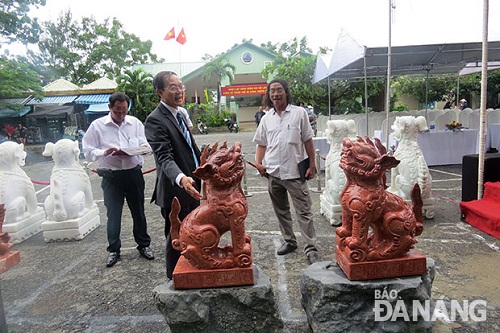Efforts to increase sales of locally-made sculptures
The Non Nuoc Stone Carving Village now has about 500 production establishments, together employing over 3,000 carvers. Around 1,000 of them specialise in carving lion and dragon statues, which bring in nearly 70% of the village’s total revenue.
Last year, the central government issued a dispatch to ask Vietnamese residents to stop buying exotic statues which are not consistent with Vietnamese habits and customs. Hence, the village’s carvers are facing a slump in sales as carved lion statues worth tens of billion VND are left in stock at the village, and this has caused them many difficulties. At that time, many of the local carvers did not know how to create the sculptures which best match the Vietnamese cultural identity.
 |
| Carvings of lions and 'nghe' on display at the exhibition |
In an attempt to deal with this problem, a contest was launched in July this year to create different designs for carvings of lions and 'nghe' (a fictional creature with the head of a lion, the body of a dog, and a long tail), both of which had to be imbued with the Vietnamese cultural identity. The 14 most outstanding sculptures created by the village’s production establishments are being displayed at an exhibition in the office of the Management Board of the Marble Mountains.
The exhibition offers an opportunity for local carvers to access some new eye-catching designs from which future sculptures might be copied.
However, the owner of a local production establishment, Mr Nguyen Long Buu, said that he and other local carvers are now worryied about how to widely introduce their new sculptures of lions and 'nghe' to local residents.
According to the municipal Department of Culture, Sports and Tourism, exotic statues which are currently on display at local historical relic sites, agencies and companies will be replaced with sculptures which best match the Vietnamese cultural identity. These products will be created by the village’s production establishments.
Importance will also be attached to raising awareness of the cultural values of such Vietnamese traditional holy animals and encouraging the public to buy these new products.
It is hoped that this will help boost sales of locally-made stone sculptures in order to further the development of this traditional craft village.